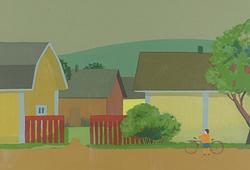Eric Grate
"Ugglegudinnan-Athena"
Signed EG and numbered 3/3. Conceived 1955. Darkpatinated bronze, height 81 cm.
Literature
Liljevalchs konsthall, "Eric Grate - sex decennier 1916-1976", 13 May - 1 August 1976, exhibition catalogue, compare catalogue no. 152.
Pontus Grate, Ragnar von Holten, "Eric Grate", SAK, 1978, ill p. 108.
More information
"Inte sällan ger Grates "fantasiskapelser" vittnesbörd om hans intresse för det förklassiska Grekland. Erfarenheterna från "Flugorna" har redovisats, men flera av konstnärens figurer från 50-talet har också släktskap med cykladiska idoler, t.ex. En sådan är givetvis Ugglegudinnan-Athena, bysten av en kvinna med mänsklig fågel-mask. Hon kan verkligen direkt upplevas som en votivbild, ett föremål för kult eller en hyllning till "det evigt kvinnliga"! Pontus Grate, Ragnar von Holten, "Eric Grate", SAK, 1978, sid 108.
Artist
Eric Grates idiosyncratic world of images always invites exploration and wandering within the imagination. While he respects the the earths natural forms, he sometimes "plays with god", manipulating and playing with nature to create new surprising objects which we recognise but simultaneously dont recall. He borrows fragments from nature and uses his endless imagination to create art in his unique way. His visual language emualtes an aura of abstract surrealism derived from "object trouvés". Grate was inspired by natures radiance and its different forms. Stones, roots, insects, bones, all were transformed into sculptures, particularly the insect world was a source of great inspiration for Grates. During the 1960s, beach, hull, and bones were particularly the starting points for his sculptures. He created numerous official artworks.
Grate began his academic trips after finishing his studies at Royal Swedish Academy of Fine Arts from 1979-20, where he travelled to Italy and Greece, filling his sketchbooks with studies of insects, plants, unique architecture, sculpture, and ceramics. He spent a longer period between 1924 and 1933 in Paris, a formative period where he was one of the few Swedish artists who was associated with the avante garde; we got in contact with none other than the surrealists Jean Arp, Paul Eluard, and Tristan Tzara. Grate is seen by many as one of Sweden's most influential sculptors during the 1900s.
Read more















































